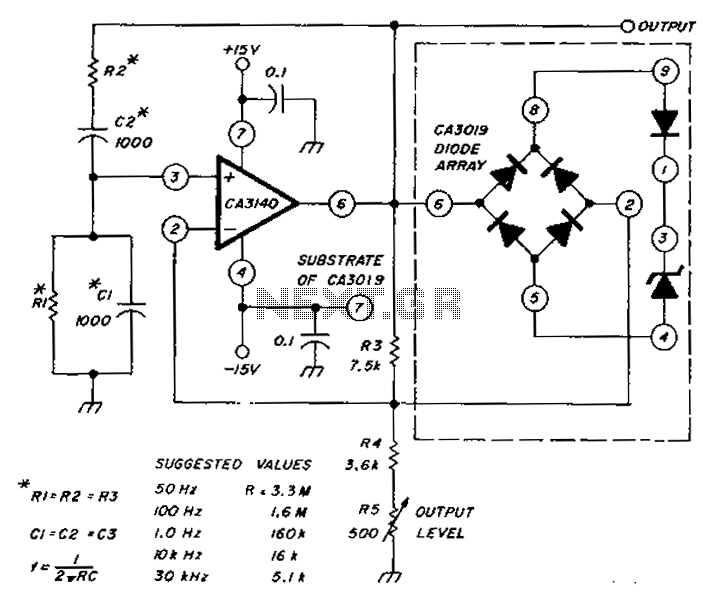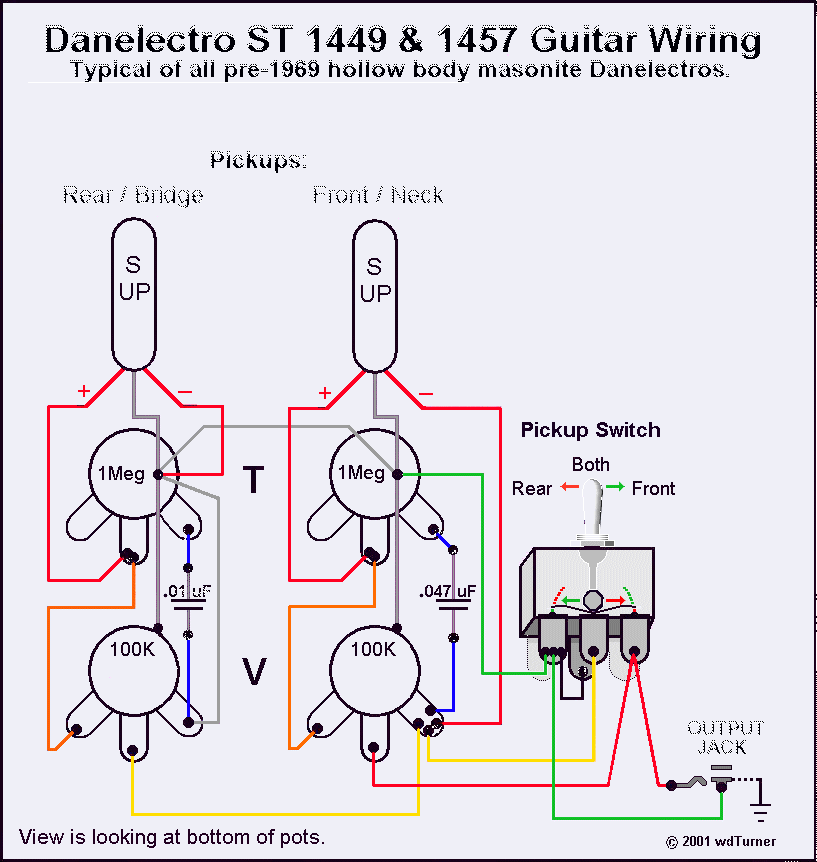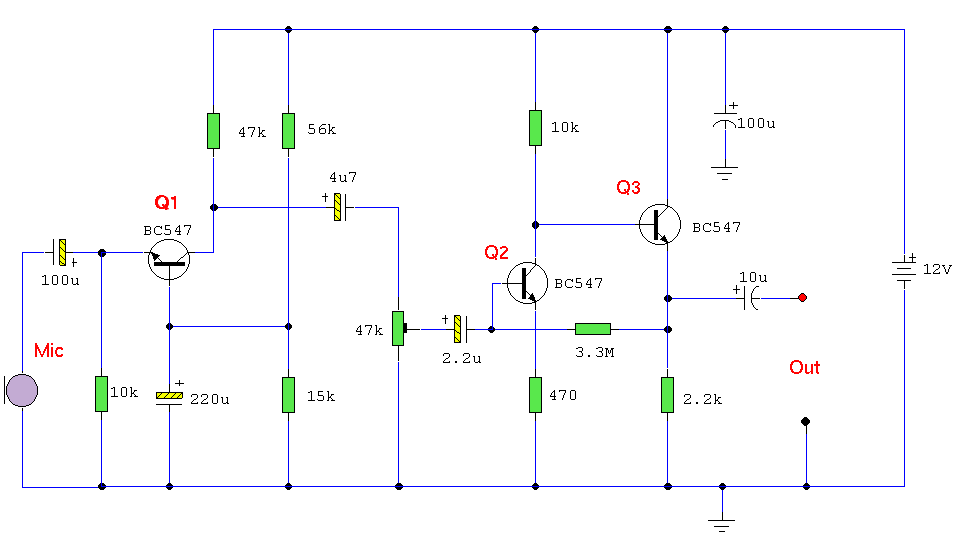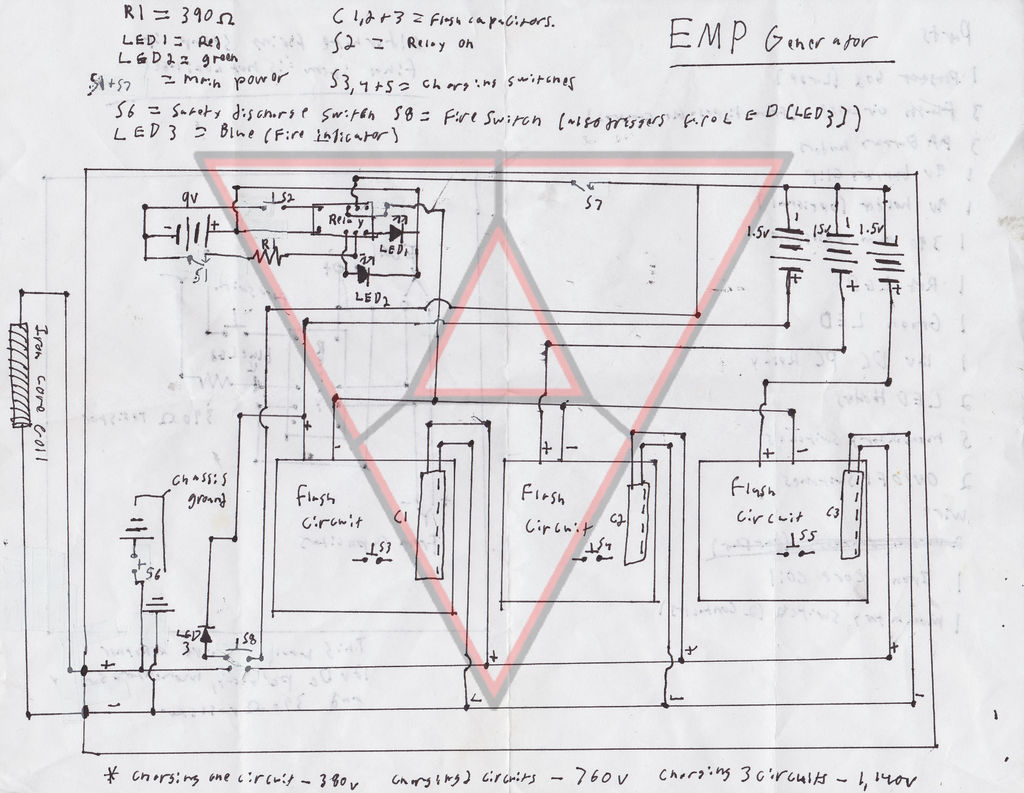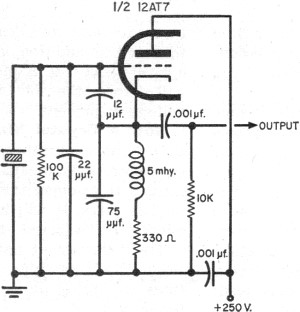
Schematic for the Micro FM transmitter

Tetsuo Kogawa's circuit is well documented, although not in a conventional schematic form. It has been entered into LTSpice for analysis, and the schematic is presented online with some comments. The circuit includes a small air variable capacitor (C1) with a maximum capacitance of approximately 18pF, set to 12pF for this configuration. A 9V supply is used, reflected in the V2 input. The power supply bypass capacitor has been modified to 0.1uF from 0.01uF, as the larger capacitor was readily available and did not adversely affect circuit performance. The inductor (L1) is valued at 0.08uH, calculated using the formula for an air-wound solenoid coil, though this value is approximate. The transistor 2n3904 has been utilized in place of the original 2SC2001. The V1 input simulates an audio signal, providing a 1000 Hz sine wave with 1V amplitude to the modulation input. The output is taken from the emitter of Q1. Further experimentation with the circuit is planned, particularly focusing on understanding deviation control and the impact of biasing with a 6V supply.
The circuit designed based on Tetsuo Kogawa's documentation utilizes an air variable capacitor (C1) that allows for fine-tuning within the specified range. The choice of 12pF capacitance is a compromise between the maximum capacity of the component and the desired performance characteristics of the circuit. The 9V supply (V2) powers the entire circuit, ensuring that all components operate within their specified voltage ratings.
The modification of the power supply bypass capacitor to 0.1uF enhances filtering capabilities, which can reduce noise and improve stability in the circuit performance. This change is particularly beneficial in audio applications where signal integrity is crucial. The inductor (L1) value of 0.08uH is derived from theoretical calculations for an air-wound solenoid, acknowledging that practical measurements may yield slightly different results due to manufacturing variances and environmental factors.
Replacing the 2SC2001 with a 2n3904 transistor introduces a commonly available and versatile component that is suitable for various applications, including amplification and switching. The transistor's characteristics will influence the overall performance of the circuit, particularly in the modulation stage.
The input signal (V1) simulates a 1000 Hz sine wave, which is a standard frequency for testing audio circuits. This input is critical for assessing the modulation effects on the output signal, which is taken from the emitter of Q1. By monitoring this output, insights can be gained into the circuit's response to varying input conditions.
Future experiments are anticipated to focus on quantifying the deviation in the circuit's performance and exploring methods for control. Additionally, the impact of changing the supply voltage to 6V on biasing and overall circuit behavior will be investigated, which may provide valuable insights for optimizing performance in practical applications. This systematic approach will contribute to a deeper understanding of the circuit dynamics and potential enhancements.Tetsuo Kogawa`s circuit is pretty well documented, but not in conventional schematic form. I decided to enter it into LTSpice to see what it could make of it, and decided to go ahead and put the schematic online here, with perhaps a few comments: I`ve set this up more or less as I built the circuit: in my circuit C1 is a small air variable cap tha t goes up to about 18pF, so I`ve set it to 12pF here. I use a 9V supply, so that`s what I put in for V2. I changed the power supply bypass cap to be 0. 1uF instead of 0. 01uF, since I have a bag of 0. 1uF ones, and it doesn`t seem to affect the circuit. The L1 value of 0. 08uH was determined by plugging numbers into the formula for an air wound solenoid coil: it`s probably only very roughly what the inductance actually is. Instead of the 2SC2001, I went ahead and put in the 2n3904 that I used. V1 is supposed to model the audio input, supplying a 1000 Hz, 1V amplitide sine wave to the modulation input.
The output should be tapped from the emitter of Q1. I`m going to experiment with the circuit a bit more: I`m particularly interested in jigging this up so I can figure out what the deviation is likely to be, and how it can be controlled, and how the biassing might change with a 6V supply. 🔗 External reference
The circuit designed based on Tetsuo Kogawa's documentation utilizes an air variable capacitor (C1) that allows for fine-tuning within the specified range. The choice of 12pF capacitance is a compromise between the maximum capacity of the component and the desired performance characteristics of the circuit. The 9V supply (V2) powers the entire circuit, ensuring that all components operate within their specified voltage ratings.
The modification of the power supply bypass capacitor to 0.1uF enhances filtering capabilities, which can reduce noise and improve stability in the circuit performance. This change is particularly beneficial in audio applications where signal integrity is crucial. The inductor (L1) value of 0.08uH is derived from theoretical calculations for an air-wound solenoid, acknowledging that practical measurements may yield slightly different results due to manufacturing variances and environmental factors.
Replacing the 2SC2001 with a 2n3904 transistor introduces a commonly available and versatile component that is suitable for various applications, including amplification and switching. The transistor's characteristics will influence the overall performance of the circuit, particularly in the modulation stage.
The input signal (V1) simulates a 1000 Hz sine wave, which is a standard frequency for testing audio circuits. This input is critical for assessing the modulation effects on the output signal, which is taken from the emitter of Q1. By monitoring this output, insights can be gained into the circuit's response to varying input conditions.
Future experiments are anticipated to focus on quantifying the deviation in the circuit's performance and exploring methods for control. Additionally, the impact of changing the supply voltage to 6V on biasing and overall circuit behavior will be investigated, which may provide valuable insights for optimizing performance in practical applications. This systematic approach will contribute to a deeper understanding of the circuit dynamics and potential enhancements.Tetsuo Kogawa`s circuit is pretty well documented, but not in conventional schematic form. I decided to enter it into LTSpice to see what it could make of it, and decided to go ahead and put the schematic online here, with perhaps a few comments: I`ve set this up more or less as I built the circuit: in my circuit C1 is a small air variable cap tha t goes up to about 18pF, so I`ve set it to 12pF here. I use a 9V supply, so that`s what I put in for V2. I changed the power supply bypass cap to be 0. 1uF instead of 0. 01uF, since I have a bag of 0. 1uF ones, and it doesn`t seem to affect the circuit. The L1 value of 0. 08uH was determined by plugging numbers into the formula for an air wound solenoid coil: it`s probably only very roughly what the inductance actually is. Instead of the 2SC2001, I went ahead and put in the 2n3904 that I used. V1 is supposed to model the audio input, supplying a 1000 Hz, 1V amplitide sine wave to the modulation input.
The output should be tapped from the emitter of Q1. I`m going to experiment with the circuit a bit more: I`m particularly interested in jigging this up so I can figure out what the deviation is likely to be, and how it can be controlled, and how the biassing might change with a 6V supply. 🔗 External reference
